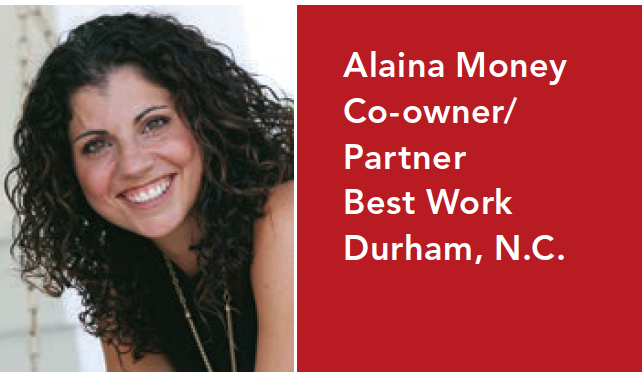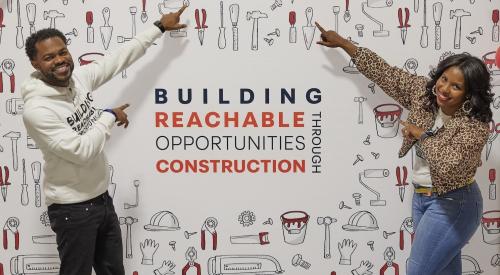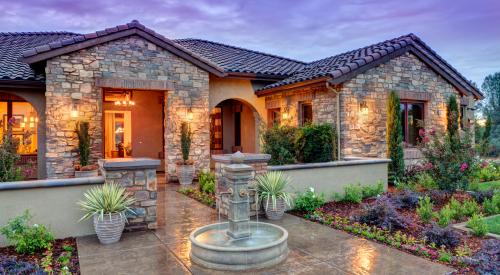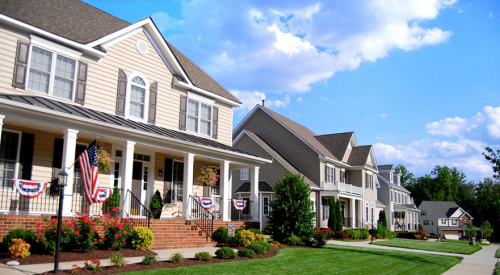Alaina Money began her career in home building working on-site sales for national builders before landing at Garman Homes, in Cary, N.C. Eventually she became division president before moving up in July to her current post with Best Work, Garman’s holding company. This year the production builder’s sales are expected to increase 24 percent to a projected $57 million with 187 closings, compared with 141 closings in 2016.
One engine for that growth was Fresh Paint by Garman Homes, a new line of houses starting at under $200,000. Another factor is the whole-home design packages that Money and Garman Homes’ division president Allison King curated, which both simplify the building process and let buyers personalize their production-built home by picking a package based on their preferred aesthetic. Money also writes the blog “Build Like a Girl,” which won a MAME award for best social media by a company.
Q: What are Garman’s expansion plans? Why these markets, and how will your responsibilities as a partner in Best Work figure in those plans?
A: Several years ago we made it our mission to align ourselves with world-class developers of [master planned communities] in our market because we wanted to build alongside the best in the business. Positioning ourselves in this way forced us to become a better builder and earn our spot lot after lot, house after house.
Our expansion strategy is to work with the same caliber of developers and solve those tough segments in MPCs, specifically where there is an opportunity to disrupt the affordable market with a design-driven product from Fresh Paint—markets such as Denver, Dallas, Austin, and Nashville. Pittsburgh is also on our list because you can take the girl out of Pittsburgh but you can’t take Pittsburgh out of the girl. Best Work—the holding company for Garman Homes, Fresh Paint, Durham Building Co., Better Homes and Gardens [Real Estate], Go Realty, and the Go School of Real Estate—is about creating a family of companies where people are inspired to do their best work. As a partner at Best Work, my responsibility will be to identify developer partners, explore and evaluate these market opportunities, make connections with the best builders in the market, and earn a chance to build alongside them.
Q: Garman is known as the builder with personality; being clever, crafty, even a little offbeat in its home market. How can you establish that brand identity in a new territory?
A: I think the fact that we’ve always allowed our freak flag to fly will help us show up in these markets in a really authentic way and with a tremendous amount of humility and gratitude for the opportunity to just be there. We’ve chosen markets where we think we have the best chance for people to get who we are and understand that it’s about so much more than just building homes for us. It’s about creating places where people are inspired to live their best life; to get more than they expect; to understand how personal this is for us. I’d like our brand identity to be inspired by the cities where we build and by the people who have made those cities their home. My mission will be to find out how Fresh Paint can reflect what is unique and special about each market and combine that with our commitment to #rageagainstbuilderbeige.
Q: Are the entry-level, modestly priced homes gaining traction in your markets, and is Fresh Paint by Garman having an impact on that target buyer?
A: Compared with some parts of the country, our entire market could be considered modestly priced. When buyers show up from California or parts of New York, we like to joke with them about how our houses must seem free to them! With each city we explore, we’re gaining more perspective on just how much we have to be grateful for in the Raleigh-Durham market. I do think entry-level and modestly priced homes are gaining traction in our market and will continue to do so as long as there are builders and developers that want to solve the puzzle of how to build something remarkable. It takes a certain level of investment from each stakeholder—no one can afford to be greedy. Costs are rising all the time and our ability to continue to create something that looks, feels, and lives like a much more expensive home is attracting a wider spectrum of buyers than we expected. We see first time homebuyers for sure but we also see single-parent households downsizing after divorce and empty nesters who have been there and done that and crave a simpler homebuilding process.
Another factor driving traction is the movement towards a life that is rich in experience rather than a life that is rich in stuff. There’s an entire segment of people choosing to buy homes below their means to afford a higher quality of life. An experience rich life isn’t held back by a mortgage that
keeps you up at night. Having a smaller more modestly-priced home affords other luxuries in life like travel.
We created Fresh Paint in 2015 and we were well into Q1 of 2016 before things really took off. By the end of 2016, Fresh Paint accounted for 42 percent of the homes we built during a year where we doubled in size. This year Fresh Paint will constitute 67 percent of the homes we build and we grew again by 35 percent. We’re looking at a national expansion strategy. Fresh Paint has a key efficiency that has national applications, and we think it can crack the code in affordability. Home builders, in order to make houses more affordable, keep the square footage and strip out the features. We think we can address affordability by condensing square footage and adding more features.
Q: Social marketing is a good part of Garman’s marketing, and you’ve said previously that one goal of your outreach is to get people to know us. What are you considering to introduce Garman to the community?
A: We’re going to bring people along on the adventure. My blog, “Build Like a Girl” started as a place to share my adventure as a salesperson trying to learn how to build a home. In January, we’re going to relaunch Build LIke a Girl as the place where we share the story of our national expansion. I share it all, the good, the bad and the humbling.
Q: Your blogs have been less about the house and more about the experience such as the emotions behind the decision to build a home for the widow of a fallen soldier and the challenge of passing a framing and mechanical inspection†on the first attempt. What is your process for deciding what you are going to write about and not write about. I imagine that would be the cliché content that is found on most homebuilders’ websites?
A: I feel very strongly that the blog needs to be the space where people can get to know us in a really genuine way. That means writing about whatever is on our minds. Our work is very personal to us. I chose to write about the stuff that other builders won’t write about because there’s so much white space there. I write about our mistakes. I write about our struggles. I write about how much I admire and respect our competitors. I write about what matters to us and why we get up in the morning. Buyers should feel good about the people constructing their home. I want people to feel like they have a chance to get to know us. The blog is the space where we share the behind the scenes and insider info that either attracts people to us or repel them from us. Repelling is just as important as attracting - we’re not the right builder for everyone. I would rather someone find that out sooner than later. A miserable experience for the buyer is just as miserable for the builder. If you find what I write on our blog and our website offensive, chances are you will find us offensive. That’s ok, there are plenty of non-offensive builders out there who would love to build you a home.
Q: Can you share analytics about Build Like a Girl or perhaps some anecdotes/examples about readers who became prospects/clients?
A: We’ve never measured the success of Build Like a Girl with traditional metrics. I don’t say that to make marketers heads explode with rage, I say it because it’s true. The real value of Build Like a Girl is the opportunity to connect. It’s when I write an entry and someone pulls me aside and tells me how it made them feel or made them think or taught them something new. My hope is that the blog earns us the benefit of the doubt when we stumble and that it resonates with ordinary people trying to do extraordinary things. If we can do it, so can they.
Q: Was there any trepidation about writing about your mistakes and screwups?
A: Writing about our mistakes was not a discussion. When I write, I write about what is in my head and on my heart in that moment. So including our mistakes is actually part of good expectation setting. If you promise the client a perfect home where nothing goes wrong, you’re doing a disservice to that client because that is what they’re going to expect. It’s human to make a mistake, and we can keep it in that perspective. I don’t gloss over or think it’s always funny when we do make mistakes, but it’s also a good way to show how you will respond. I’m reading Sheryl Sandberg’s (and Adam Grant’s) book (Option B: Facing Adversity, Building Resilience, and Finding Joy) and she describes how Navy Seals go though how a situation went badly and dissect it to understand what went wrong with the process. I hope I never stop making mistakes, but I want them to be new ones. I don’t want to repeat old mistakes.













